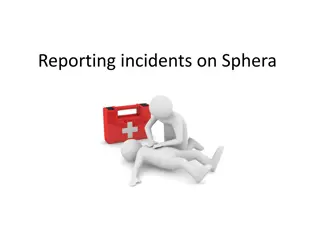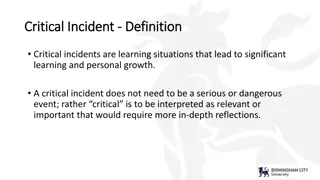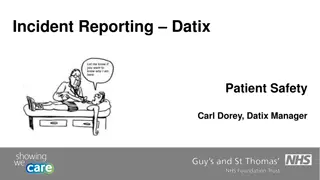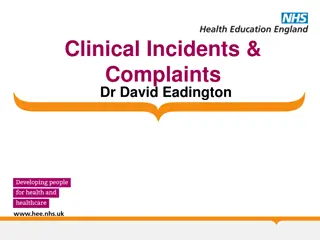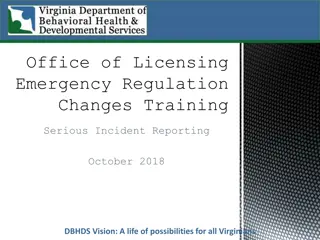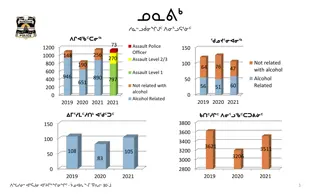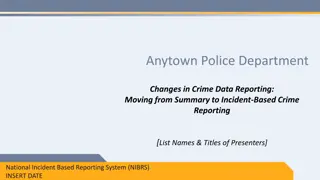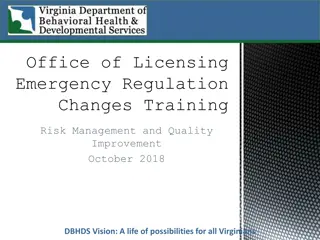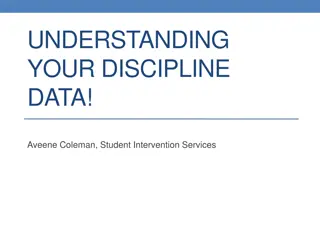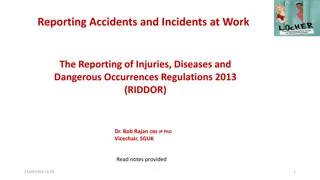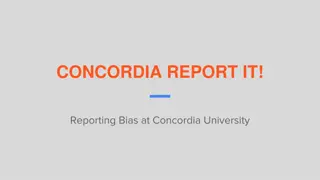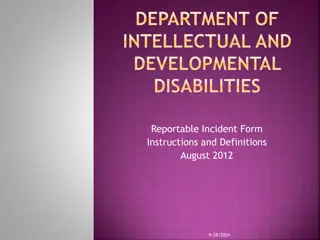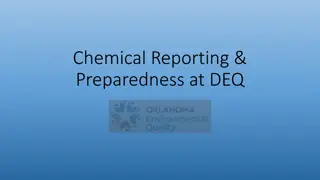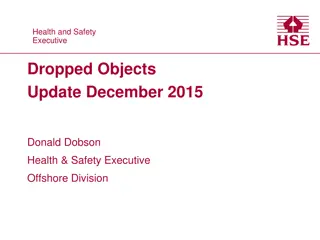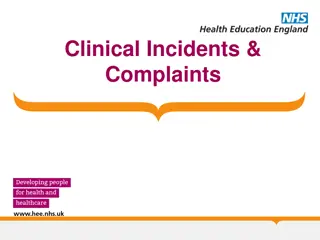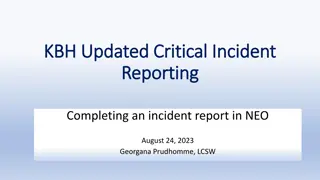Managing Critical Incidents and Reporting in Healthcare Settings
This presentation discusses the importance of incident reporting in healthcare, focusing on critical incidents, factors contributing to errors, risk management components, fair-blame culture, human error, and the impact of adverse events. It highlights statistics on medical errors, emphasizes the need for system-based approaches to prevent errors, and mentions key recommendations from the IOM report on patient safety. The content underscores the significance of learning from other industries to improve healthcare safety practices.
Download Presentation

Please find below an Image/Link to download the presentation.
The content on the website is provided AS IS for your information and personal use only. It may not be sold, licensed, or shared on other websites without obtaining consent from the author. Download presentation by click this link. If you encounter any issues during the download, it is possible that the publisher has removed the file from their server.
E N D
Presentation Transcript
CRITICAL INCIDENTS & REPORTING Dr Jimi Coker Group Clinical Adviser Lagoon Hospitals SQHN Risk Management Workshop 10/12/15
Overview Medical errors / adverse events Factors contributing Swiss cheese model Risk Components of risk management Incident reporting Fair-blame or just culture
Introduction and Background Human Error- We cannot change the human condition, but we can change the conditions under which humans work . (James Reason BMJ March 2000) 3
To err is human - USA The Institute of Medicine (IOM) study To Err is Human; Building a Safer Healthcare System http://images.nap.edu/images/minicov/0309068371.gif Adverse events occur in 2.9 to 3.7% of all hospitalizations 44,000 to 98,000 patients dies a year as a result of medical errors 5
Extent and Nature of Adverse Events in Healthcare - (UK NHS) 850,000 adverse events per year 44,000 incidents fatal Half are preventable Accounts for 10% of admissions Costs the service an estimated 2 billion per year (additional hospital stays alone, not taking into account human or wider economic costs e.g. litigation) 6
IOM Report The IOM report made a number of recommendation on patient safety Facilities should have a non-punitive system to report and analyze errors A team should be assembled Team work can improve patient safety Safety program should be initiated using well established safety research
Personal vs System Approach Personal approach focuses on the unsafe acts sharp end - name and shame System approach errors seen as consequence not cause aim to build defences and safeguards Health care now learning from other industries High technology systems have many defensive layers - like a Swiss cheese Active failures Latent conditions Reason BMJ March 2000 8
DANGER Some 'holes' due to active failures Defences in depth Other 'holes' due to latent conditions From Reason 1997 9
Factors Contributing to Human Error Environmental Factors Light Noise and Vibration- Alarms! Temperature Humidity Restrictive/ protective clothing Equipment layout and design Physical environment 11
Factors Contributing to Human Error Some examples of personal factors Fatigue Stress Workload Distraction Drugs/ Alcohol Hypoglycaemia Hypovolaemia 12
Discussion If people try hard enough they will not make any errors If we punish people when they make errors, they will make fewer of them 13
Discussion If people try hard enough they will not make any errors If we punish people when they make errors, they will make fewer of them 14
Risk Likelihood, high or low, that some one or something will be harmed by a hazard, multiplied by the severity of the potential harm. Risk = Severity x Likelihood
Risk Management Systematic application of management policies, procedures and practices to enable the organization identify, assess, treat and monitor risk Organizational culture accepted as normal practice No one comes to work to make a mistake or hurt someone
Components of risk management Identification Analysis and evaluation Control Review
Components of risk management Identification Incident reporting / Occurrence form Complaints Claims Training Analysis and evaluation Control Review
Components of risk management Identification Analysis and evaluation Risk register Risk scoring system or safety assessment matrix Audit (M & M) Root cause analysis Control Review
Components of risk management Identification Analysis and evaluation Control Policies and procedures Audit of compliance Staff education (induction and updates) Review
Incidence reporting Record of events Sources of risk Pro-active process Near misses Responsibility of ALL staff in the organization
Form Type of incident Occurrence Accident Medication error Equipment etc. Location Date and time Observed contributing factors Observed or recorded attributable injury
Incidence reporting Timely Accurate Errors and near-misses Conducive environment by management No blame versus fair-blame or just culture Individual versus system failures Anonymity versus feedback to reporter
Definitions Incident Accident, event or occurrence that led to harm, loss or damage to people, property or reputation Near miss Occurrence that could potentially have led to harm, loss or damage Sentinel event or serious untoward incident (SUI)
Definitions Adverse patient incident - any event or circumstance arising during healthcare that could have or did lead to unintended or unexpected harm, loss or damage. Harm - injury (physical or psychological), disease, suffering, disability or death. Incidents that lead to harm- Adverse Events. Incidents that do not lead to harm - Near Misses. Other terms which may be used - clinical incident, critical incident, serious untoward event, significant event (National Patient Safety Agency 2001) 25
Incident categories Clinical administration Clinical process/procedure Documentation Healthcare associated infections Medication/ IV fluids Blood/Blood products Nutrition Oxygen/gas/ vapour Medical device / Equipment Behaviour Accidents Patients & staff Resources
Levels of harm None near miss Mild minimal or short term loss of function Moderate intervention required, prolonged LOS, permanent or long term loss of function Severe life-saving or major surgical or medical intervention, expectancy, permanent or long term LOF Death shortened life
Sentinel event (SUI) Incident or accident occurring in hospital Results in death or permanent harm to patients, staff or the public Significant loss or damage to property or environment Likely to be of significant public concern Must be reported immediately or no more than 24 hrs
Sentinel events - types Never events Failure to act on a significant abnormal investigation Unexpected death within 24 hours of surgery or invasive investigation Death or injury following delay in undertaking necessary investigation or procedure
Never events Wrong site surgery Retained swab or instrument Misplaced nasogastric or orogastric tube not detected before use Maternal death from PPH after CS Infant discharged to the wrong person Intravenous administration of concentrated KCl Transfusion of incorrect blood group
Factors Contributing to Successful Error Reporting Culture - just, reporting, flexible, learning Accept human fallibility even good doctors! Training on safety issues Annual appraisal Ground rules established - acceptable and unacceptable behaviour 31
Factors Contributing to Successful Error Reporting Support / trust / leadership Well run implemented with good communication Consistency Clear instructions Anonymity Confidential Voluntary - good input and change 32
Barriers to Successful Reporting Fear of individual / organisational repercussion Defining reportable errors too narrowly Length of contract / time in job Workload involved - usually time (form filling) Culture of fear of losing an otherwise good nurse / doctor Where reporting has not brought about change Uncertainty right and wrong - differing opinions 33
Tip of the Iceberg 1x case of damage critical situations 10x 100x mistakes 1000x deviation
General Principles of a Critical Incident Reporting System
General Principles of a CIRS Learning device for continuous use Anonymity Autonomy Voluntariness Simple reports No blame-culture / Just culture Clear definition of the contents of the reports Data confidentiality, confidentiality of information Analysis by experts Management support & resources Feedback
Setting up critical incident reporting system Policies and standard operating procedures Culture of safety Forms Readily available and accessible Encouraged to complete (emphasize preventive benefit) Team to review incidents Frequency no less than weekly Empowered Aggregate and analyze Management support Feedback Individuals Group (Lessons of the month)
System of accountability Optimal system of accountability to support patient safety Support of System Safety Blame-Free Culture Punitive Culture
Just Culture There are three duties Duty to follow a procedural rules Duty to avoid causing unjustified risk or harm Duty to produce an outcome Human factor design to reduce the rate of error Anaesthesia machines and the connecting valves Redundancy to limit the effects of failure (mistake proofing) Balance duty against organizational and individual values 40
Just Culture Just Culture recognizes the difference human error (such as slips or genuine mistakes) at-risk behavior (such as taking shortcuts) reckless behavior (such as ignoring required safety steps like bar coding and having second person double check high risk drugs) In contrast to an over reaching "no-blame" approach It is important to note that the response is not based on the severity of the event Reckless behavior such as refusing to do a time out would merit punitive action even if the patient was not harmed 41
Just Culture Accountability Human errors inadvertent actions like slips, lapse or mistakes Manage through processes, procedures, training and design CONSOLE At-Risk Behavior- behavioral choice that increases risk where risk is not recognized or believed to be justified Manage through removing incentives for at risk behavior and creating incentives for healthy behaviors and increasing situation awareness COACH Reckless Behavior- choice to consciously disregard substantial or unjustifiable risk Manage through remedial action or punitive action PUNISH 42
Summary Critical incident reporting integral part of risk management Culture of patient safety provides conducive environment Management support is essential and needs resources Aggregate, analyze and act on the incidents reported Increasing move from no blame to fair blame




